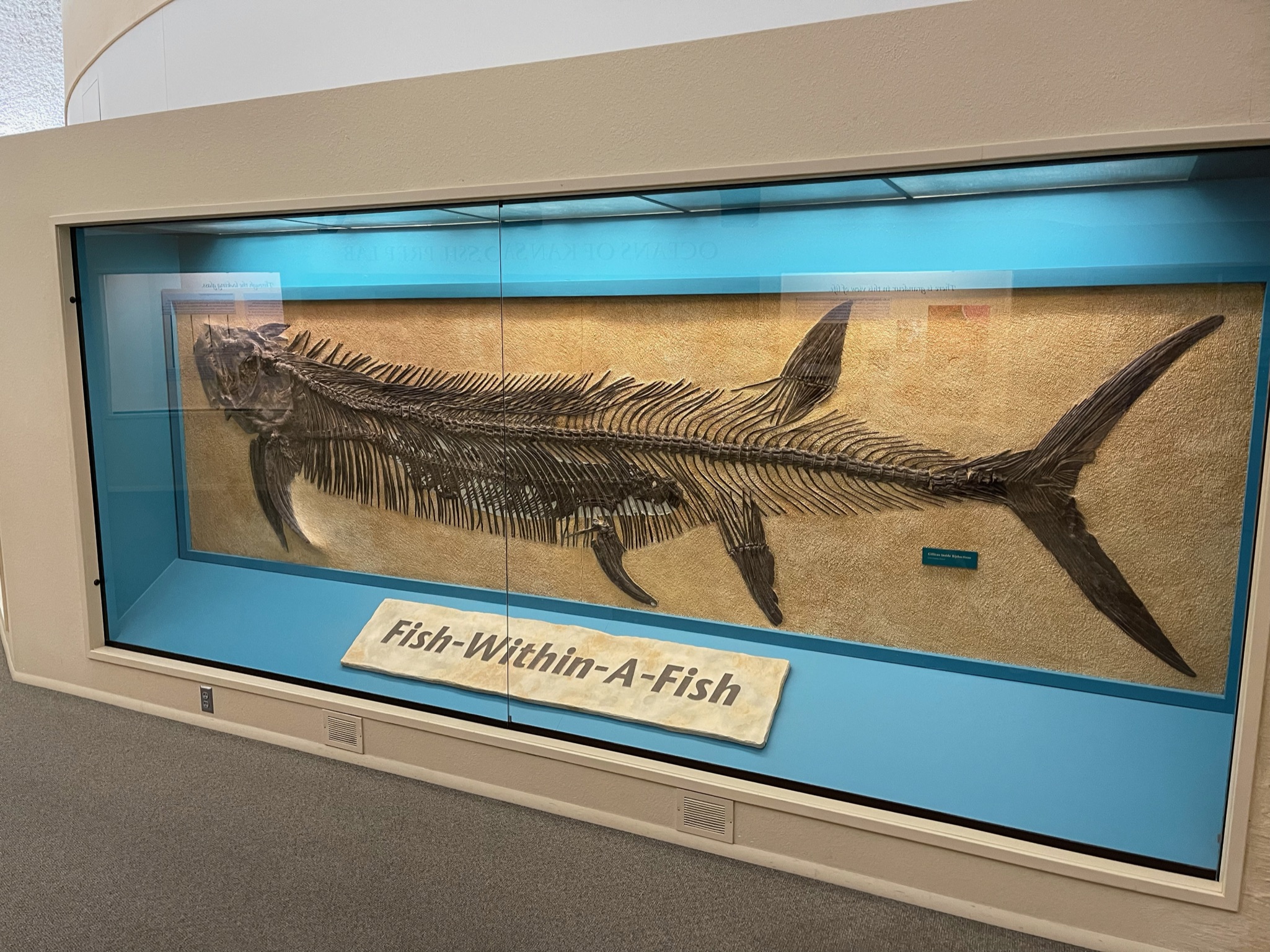August 6, 2021
For millions of years fossils have been forming in the Great Plains, originating in the now extinct Western Interior Seaway. Talk about a severe case of global warming!
Today, we will learn a lot about the history of Western Kansas, see some unusual rock formations, learn about the most famous buffalo hunt ever, and visit a couple of museums dedicated to prairie life.
1. Fabulous Fossils Await: Sternberg Museum of Natural History – Hays, KS
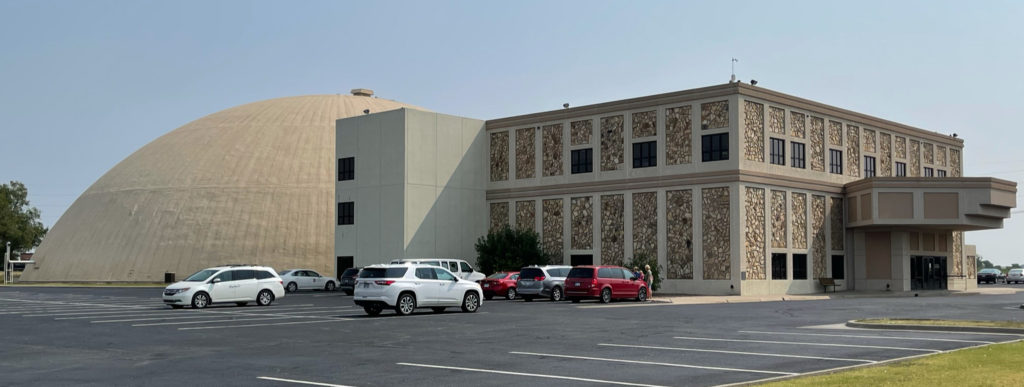
As you approach Hays from the east on I-70, just before exit 159, you can’t help but notice a large water tower with a huge domed structure nearby dominating the skyline. That dome houses about half of the exhibits of Fort Hays State University’s Sternberg Museum of Natural History. The remainder of the exhibit is in the modern two-story building that is attached to the dome.
The museum has the remains of dinosaurs, prehistoric animals, giant sea-swimming creatures, and fish, that inhabited this region 80 million years ago. It includes a 1952 discovery by curator George F. Sternberg of the famous “fish-within-a-fish”, that is the most complete known specimen of its kind.
2. Dem bones, dem bones, dem dry bones are preserved a Ft. Hays State University – Hays, KS

It is not surprising, that the museum is named after the Sternberg family since they have been the “first family” of fossil hunting here since 1866. Beginning with Dr. George M. Sternberg, a Civil War surgeon assigned to a fort in the area and who helped identify fossil bones found by soldiers on patrol in western Kansas. George bought a ranch near the fort and his brother Charles H. Sternberg joined him as the manager. Charles developed a passion for finding fossil leaves and many of his finds are in larger museums in North America and Europe.
Charles’ three sons: George F., Levi, and Charles M., also became avid fossil hunters with George F. discovering a plesiosaur at age nine, leading him to a career as a collector. He became curator of the museum in 1928 and remained with the college until his retirement in 1962. In 1969, the museum was named after his family.
Oh yes and BTW, don’t miss the three dozen or so rattlesnakes that call this place home. Seniors can gain admission for $8.
3. US Army provided security out of Old Fort Hays – Hays, KS
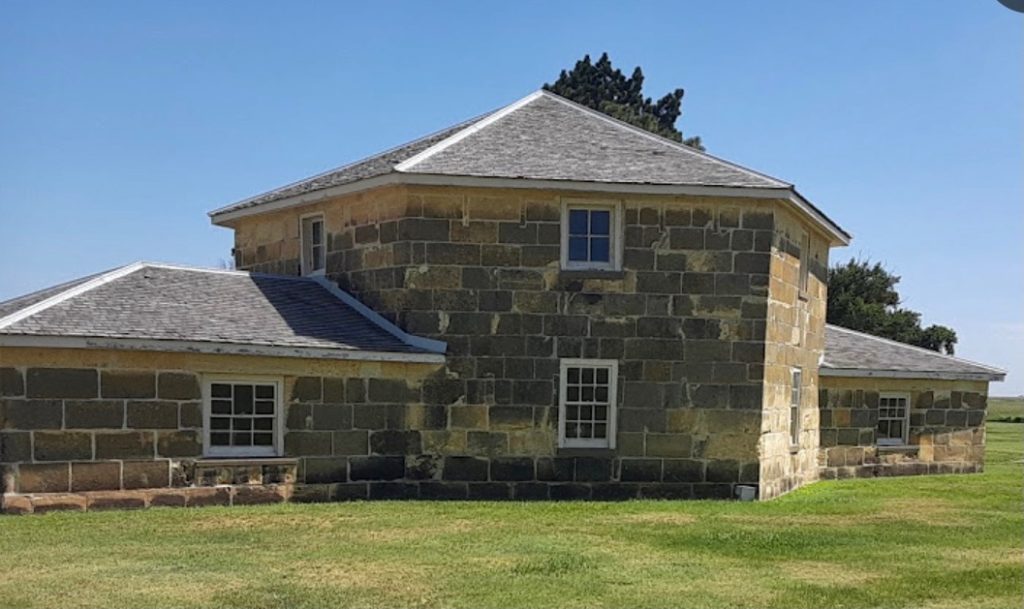
Dating back in time a lot fewer years than the Sternberg fossils is the Fort Hays State Historic Site, which was named for a Civil War general, Alexander Hays. Originally named Fort Fletcher, it was established in 1865 in the land of the Cheyenne and Arapaho Indians to provide protection for settlers and railroad workers on the Smoky Hill Trail. It was an active frontier post until 1889. And was re-opened as a historical park in 1929.
Today, the original blockhouse, a guardhouse, the officer’s quarters and a visitor’s center can still be seen, although there were nearly 45 structures during the Fort’s peak of activity during the Indian wars.
At various times, the Fort housed: the 7th Cavalry, George Custer, and the all-black Buffalo Soldiers of the 9th and 10th Cavalry. Buffalo Bill Cody and Wild Bill Hickok both served as Army scouts out of this encampment.
4. Larks Park is on the path to the MLB – Hays, KS

If you happen through Hays from early June to early August, you might hit town when the Hays Larks baseball team is in action.
Larks Park is home to the Larks, an NCAA sanctioned summer collegiate league baseball team, and the Fort Hays State University Tigers. This historic venue is one of the oldest baseball facilities in the state. Admission is free.
A couple of the more famous alumni of the Larks were two of my favorite St. Louis Cardinals, Albert Pujols (in 1999) and Lance Berkman (in 1995).
In addition to baseball, Ft. Hays State University fields teams in every major collegiate sport and competes in a 14-team conference that has schools from four states.
5. Walter Chrysler, Railroad man turns auto maker – Ellis, KS

Most of the automotive greatness achieved by Walter P. Chrysler was accomplished in Detroit, MI, but to get details of his early life, a stop in Ellis, KS (Take exit 145 off of I-70) to see the Walter Chrysler Boyhood Home and Museum would be in order. There you will find his boyhood home with a small, attached museum that features a mint-condition 1924 Chrysler.
Chrysler lived in Ellis from age 3 until the age of 22, having been brought there with his family while his father worked as an engineer for the Kansas Pacific Railroad. Walter apprenticed as a railroad machinist and then moved to Salt Lake City, before beginning to dabble in the fledging automobile industry.
This site shouldn’t take you long to explore, since it consists mainly of pictures and text about Chrysler.
It’s just hard to drive by a sign that touts the existence of Chrysler’s boyhood home, when I’m cruising along in one of his motor products.
6. You will be “bluffing” on the Smoky Valley Scenic Byway drive to WaKeeney, KS
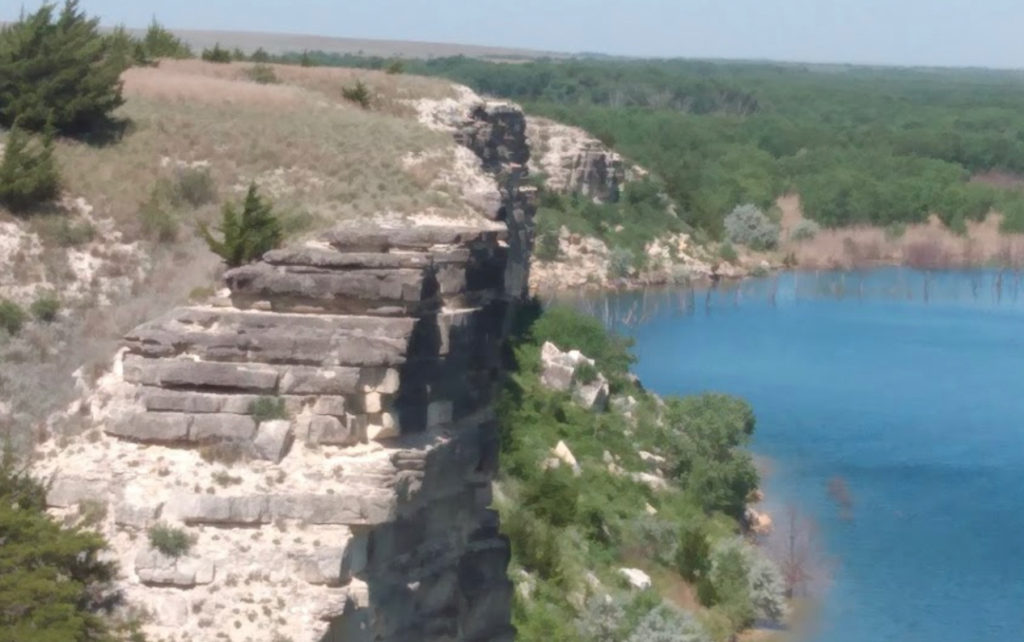
If you need a respite from museums, exit 135 at Ogallah, KS, is the gateway to a 60-mile driving tour that’s would “fill the bill”. The Smoky Valley Scenic Byway takes its name from the Smoky River, which it crosses more than once. This area is historically significant because it was the route of one of the early stagecoach lines across the state.
The Byway is a showplace for native wildflowers and grasses as it heads south on Hwy 47 along the bluffs at Cedar Bluff State Park and Reservoir. There you might spy some bald eagles, before turning west on Hwy 4 for nine miles and then heading back north on Hwy 283 to WaKeeney at exit 128.
7. Castle Rock starts the scenic route to Oakley, KS
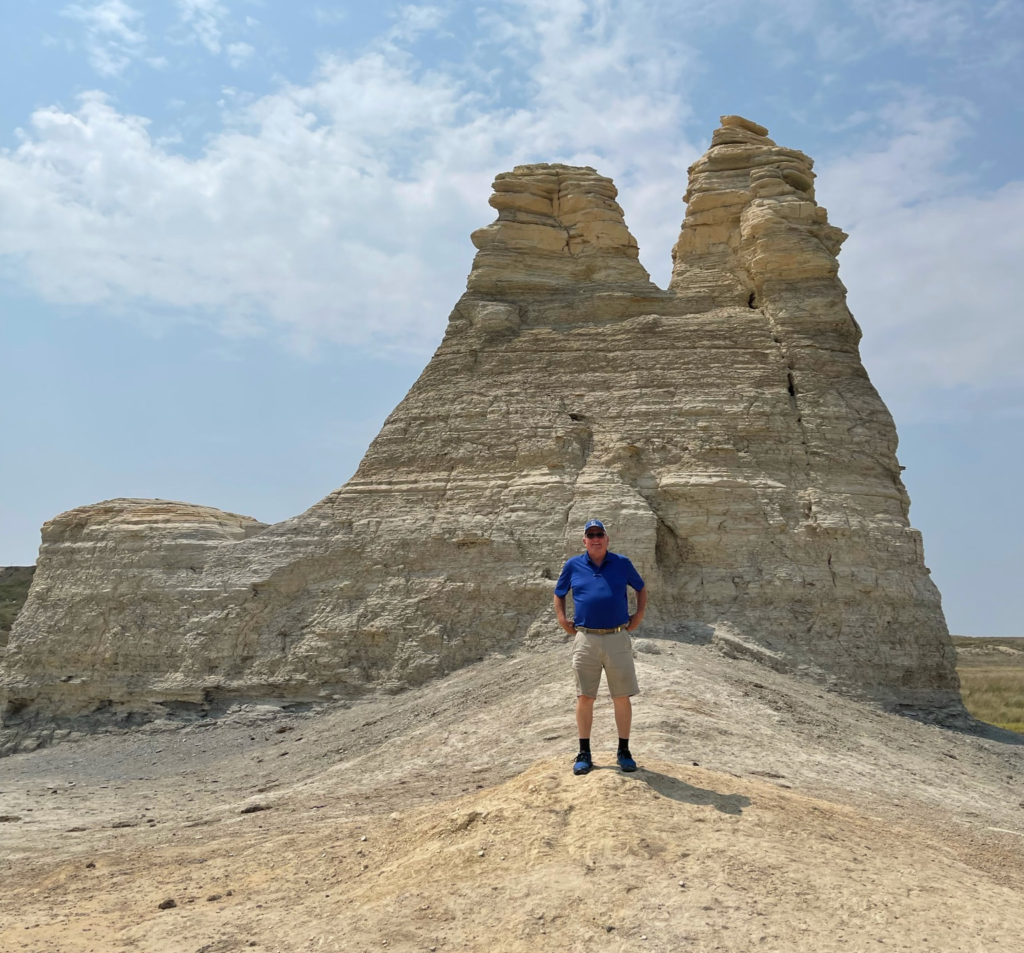
If you are in a hurry to get farther west, you will want to stay on I-70 for a 50-mile sprint to Oakley, KS at exit 76. But be fully aware, that there is a scenic alternative of unpaved roads that run roughly parallel to I-70, but about 20 miles south. This route will take you to three of the state’s most iconic rock formations. These formations are chalk bluffs that are a haven for fossil seekers. I’m going to proclaim this the mini-Badlands tour.
If you choose this latter route, turn off of I-70 at exit 107 in Quinter, KS, drive south about 12 miles and four miles east. Follow the signs until you reach Castle Rock. This formation pops up out of the rolling plains and is located on private property. It has not been commercialized, so be prepared for gravel roads and then dirt and be prepared to cross a cattle guard or two. If it is rainy, I’d forego this drive because the roads at the Rock could be slick. Four-wheel drive would be helpful, but we made it with a front-wheel drive SUV.
Don’t get your expectations too high for this site, it is only a small fraction of the area of the South Dakota Badlands, but it is a small “taste” of them and is certainly different than the terrain we have seen so far in Kansas.
8. Monument Rocks: One of Kansas’ Eight Wonders – near Oakley, KS
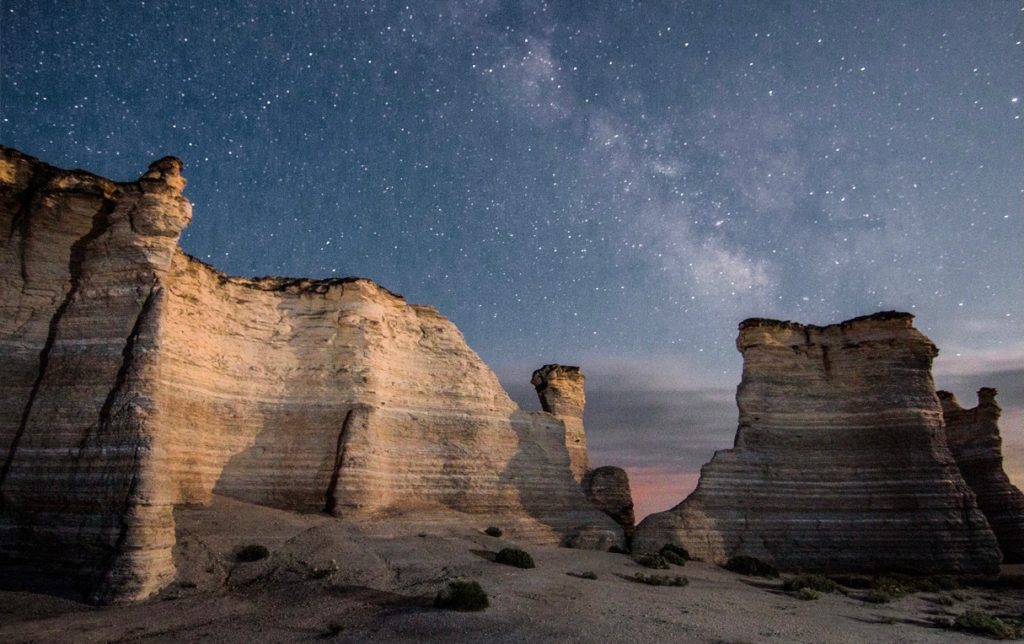
Forty miles due west on gravel roads, you will find Monument Rocks Natural Landmark located about 20 miles south and east of Oakley. These chalk pyramids were the first National Natural Landmark in Kansas, as designated by the Dept. of Interior in 1968. Their 70’ tall limestone bluffs make them one of the Eight Wonders of Kansas.
9. Little Jerusalem Badlands State Park – Oakley, KS

You will be delightfully pleased by the Little Jerusalem Badlands State Park, which is located 20 miles south and a short distance west of Oakley and about 20 miles due west of the Monument Rocks. This 332-acre tract with 220 acres of badlands only became a state park in 2018, but has rapidly become a “hot spot” for westward travelers.
The mile-long valley of towering rocks, cliffs, and canyons are Niobrara chalk formations and there are two hiking paths to take you to scenic overlooks with two miles being the longest walk. There is a $5 parking fee. The Park is owned by The Nature Conservancy after having been family-owned for five generations.
10. Buffalo Bill Cody: Where the legend began – Oakley, KS

Oakley, KS is known as the “birthplace of the legend” of Buffalo Bill Cody and for good reason. Just 10 miles west of here in 1868, he bested William Comstock in a battle to see which of the two could kill the most buffalo in an eight-hour time-period.
Cody was killing buffalo to provide meat for workers on the Kansas Pacific Railroad and Comstock was feeding the soldiers at Ft. Wallace at the same time.
As the argument raged over who was the better hunter, a wager was soon arranged of $500 between the two factions and the contest was on. Spectators, reportedly, came by rail from as far away as St. Louis to watch the event.
Cody bagged 69 of the beasts while Comstock brought down 46. Thus, the money and the “greatest” title went to Cody, who was from then on known as Buffalo Bill. A moniker that played well in his later years of putting on wild west shows.
The Buffalo Bill Cultural Center and Sculpture are located on Hwy 83 on the west side of town and admission is free. The bronze sculpture is a twice-life-size creation that is 16’ tall, weighs 9,000 lbs. and was voted one of the 8 Wonders of Kansas Art.
11. Grain bin as Visitor’s Center – Colby, KS

Driving into Colby, KS, exit 53 off of I-70 will take you to the Colby Visitor Center, an eclectic modern design of native Kansas limestone built around a grain bin and is one of the more unusual visitor’s centers we saw on the 20-day trip. It represents the important impact that wheat has in this part of the state.
12. Cooper Barn (state’s largest) at Prairie Museum- Colby, KS

To better understand Western Kansas and its history, you would do well to visit the Prairie Museum of Art & History. It’s worth the $6 senior admission fee.
The 24-acre site interprets art and history by using several structures, including: a sod house; a 1930’s homestead; a 1915 country church; an 1887 one-room school; and the Cooper Barn.
The barn is the largest barn in Kansas and contains an extensive agricultural exhibit, “Prairie Grasses to Golden Grains”, and a 7,000 sq. ft. exhibit of machinery, tools, and photographs. Before being moved to the museum grounds, the barn previously was the home to a nationally renowned herd of Hereford cattle.
13. Historical Kuska Collection: Prairie Museum – Colby, KS

The 21,500 sq. ft. main museum building houses a gift shop and the world-class Kuska Collection of dolls, glass, ceramics, furniture, textiles and toys.
What the Kuska collection consists of and how it came to be in Colby is a good story in itself. Nellie McVey Kuska was a local school teacher, who was a life-long collector. In fact, she had a local radio program about her collectibles.
In 1913, agronomist Joseph Kuska came to town to work at the Kansas State University experiment station. He and Nellie were married in 1917.
In 1957, the couple moved to Lomita, CA and opened the Kuska Museum. They continued to add to the collection and operated the museum until Nellie’s death in 1973. The Kuska Foundation donated their collection to the people of Thomas County (Kansas) in 1975. It took more than three moving vans to move the 17 tons of artifacts to Colby, where it makes a valuable contribution to the quality of the Prairie Museum.
14. World’s Largest Easel: Van Gogh Sunflowers Painting – Goodland, KS
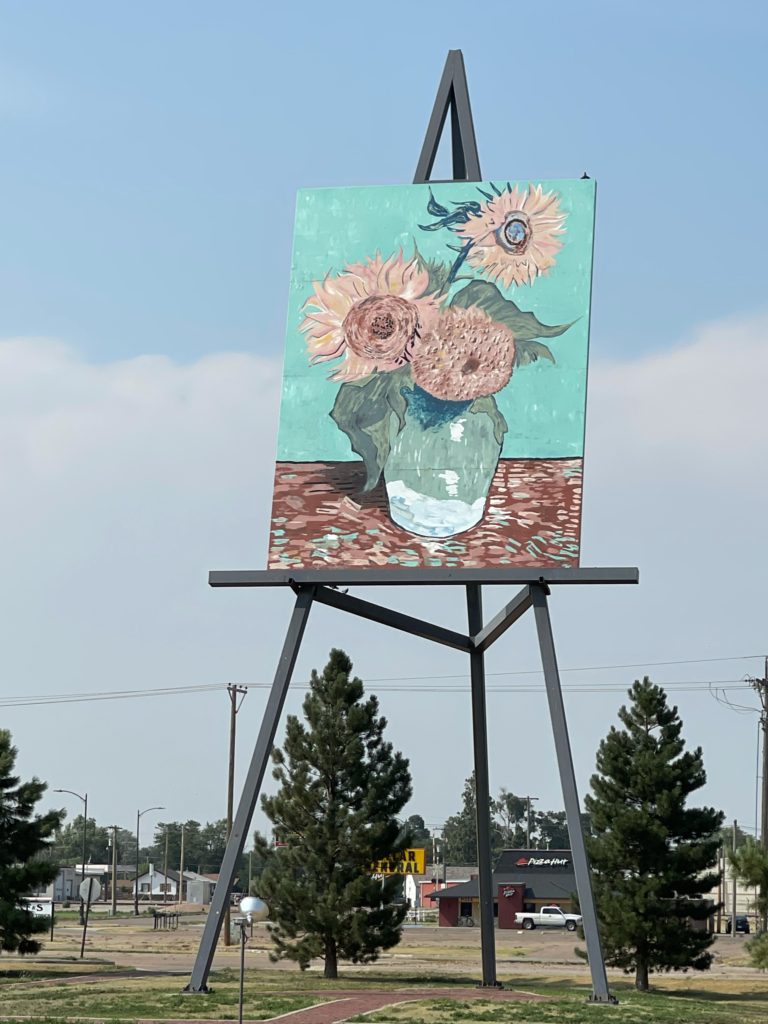
One last county-seat town remains along I-70, after three long days of exploring the width of the state. Goodland is located at exit 17 and has a couple of very unusual places to visit.
The (self-proclaimed) World’s Largest Easel features an enlarged copy of the Van Gogh painting, “Three Sunflowers in a Vase”. That selection is certainly appropriate for Kansas, which is the “sunflower” state. This painting is one of seven famous sunflower paintings by Van Gogh completed in the late 1880s.
Canadian artist Cameron Cross presented the “giant easel” idea to the trade group, Sunflowers USA, in 2000 and they raised the $150,000 it would cost to build. By 2001, it was dedicated during Goodland’s Sunflower Festival. Cross has erected three of the seven paintings and continues his quest to complete all seven in his lifetime. The previous two were done in 1998 and 1999.
The easel is 80’ tall and atop it rests a representation of the famous painting that is 32’ x 24’. It is made of steel and weighs 45,000 lbs. with supports sunk 35’ into the ground. The painting is 768 sq. ft., which doesn’t come close to the world record of over 40,000 sq. ft.
15. First Patented Helicopter: High Plains Museum – Goodland, KS
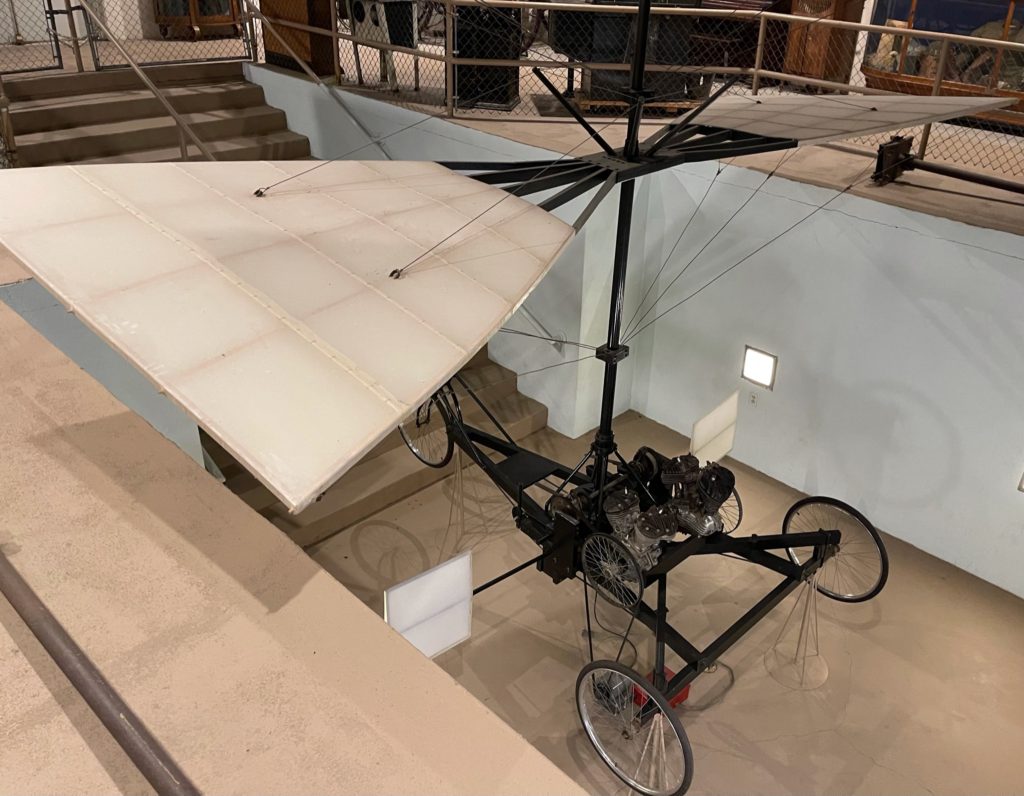
An oddity nearly equal to the giant easel in my mind, is the World’s First Patented Helicopter. We saw the replica that graces the High Plains Museum in Goodland, because the original was destroyed during the maiden flight in 1909. A patent was approved in 1912, but arrived long after the pieces of the original had been sold for scrap.
The invention was the brainchild of railroad mechanic William Purvis and his partner Charles Wilson and they attempted to fly their gyrocopter on Thanksgiving Day, 1909. They sold shares for $10 each and raised $30,000.
Due to a series of problems the machine never was flown again and the company disbanded in March, 1911. Ironically, the patent was approved in 1912, after the company was out of existence. The two men had already left Goodland, never to return and never to meet again.
More recently, the Museum commissioned a replica of the gyrocopter. It has a special place in the museum that allows a push of a button to activate the motor to make the blades turn.
It was thirty years later, before Igor Sikorsky went into full production on the first fully controllable helicopter. Meanwhile, Purvis and Wilson have faded from the pages of history, except in Goodland.
16. Mount Sunflower: State’s highest point – South of Kanorado, KS
Heading west on the last few miles of I-70 in Kansas, you will eventually come to the state’s last exit at Kanorado, about a half mile from the state line. There is one last landmark that you might want to see, but I doubt it and don’t recommend it. Unless you are “that guy”, who relishes this type of adventure and is trying to visit the highest point in every state. And I haven’t included a photo, because it is not photo-worthy.
Mt. Sunflower is located about 20 miles to the south and a half-mile from the Colorado state line. It’s distinction is rising 4,039 ft. above sea level; the highest point in Kansas. Don’t get too excited, because it isn’t really a mountain, but rather just a high point pretty much indistinguishable from the terrain surrounding it.
It is on private property, but you are welcome to visit. Amenities include a picnic table, a free library and a sunflower sculpture made from railroad spikes. Access is over county dirt roads until you cross a cattle guard on the private dirt road on the property that takes you through a pasture to the summit.
Farewell Kansas: I love ya more than ever
You might not think it is possible to take three full days to travel across Kansas, but we’re living proof that you certainly can. Without spending any time in Kansas City, I could still easily spend a week in this state. We spent three days but didn’t even get to the northern or southern parts of the state. And you just have to spend some time in Emporia, Wichita, Great Bend, Dodge City and Garden City to get the complete picture of this great state. Plan on spending a week to do the job right!
Onward to Denver, CO
Today, we became more aware of our need to get moving more expeditiously to the west; after all we only got through Kansas on Day 4, since we only have 20 days total to make the trip. So, we kicked our vehicle into high gear and made a dash for the suburbs of Denver, promising to make fewer “rambling” stops until we reached the west coast.
Daily Trip Data
Miles driven: 379 mi
Gas price: $ 2.99 per gallon
Motel cost: $190.09
Preview of Day 5
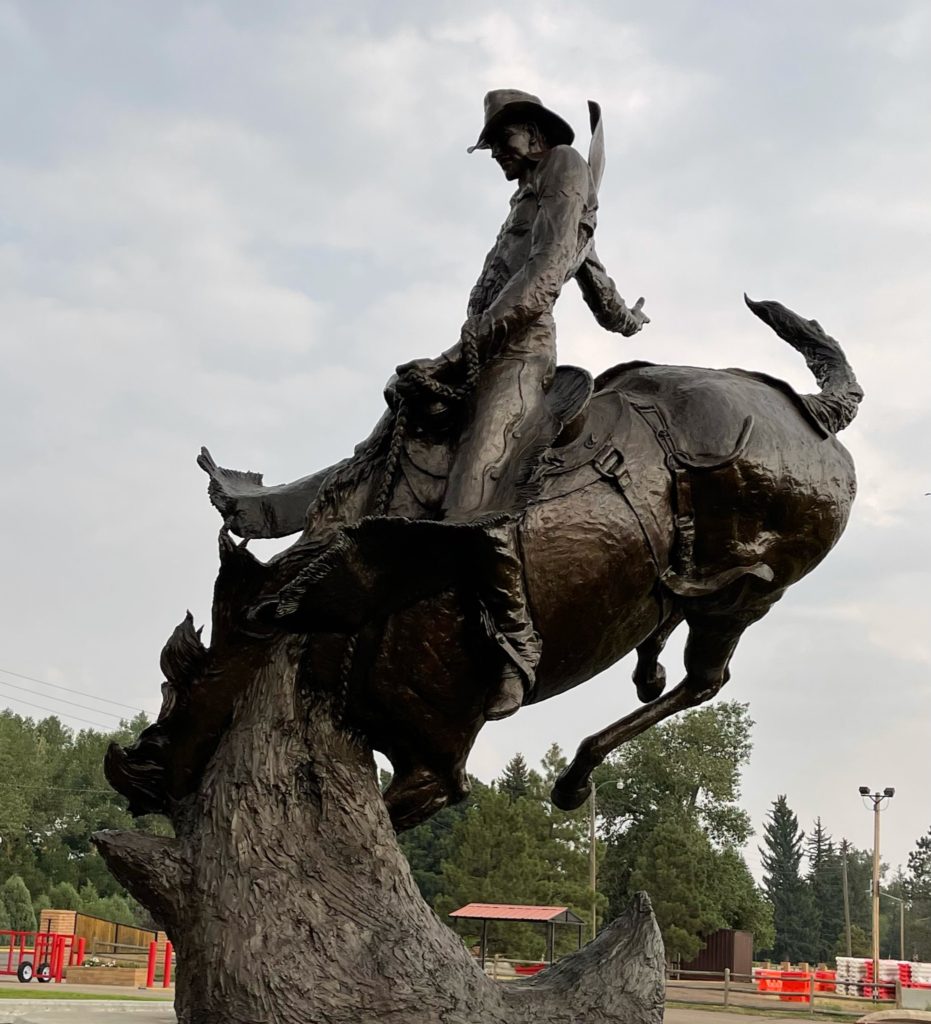
Day 5 will be spent detouring around Colorado because of mudslides west of Denver that have I-70 temporarily closed. We have opted to jog north to I-80 and cross southern Wyoming and make enough stops to become more aware of the impact of the cowboys, Indians, and the railroad that changed EVERYTHING!


